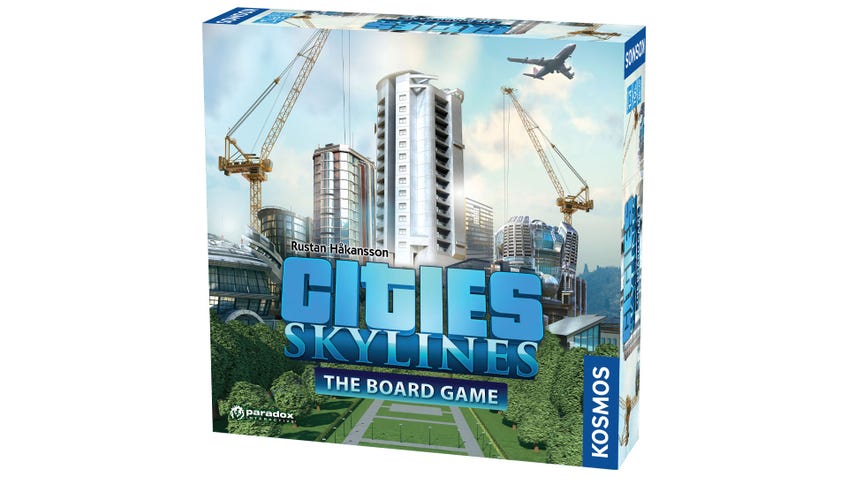Cities: Skylines - The Board Game review - co-op tabletop Tetris for careful planners
Metropobliss.
The Burnham Plan of Chicago was a landmark in city building that turned the devastation wrought by the Great Chicago Fire into an opportunity for urban renewal that produced a metropolis defined by wide streets, bountiful green space and dramatic gothic architecture. But for every city building success story there are even more failures. Venice’s waters have been essential for its economy, but now they threaten to drown it entirely. Burning coal degraded London’s air quality to lethal levels until policies were passed to reduce the pollution. Even parts of beautiful Chicago are plagued by violent crime.
All of these ambitions and problems are woven into Rustan Håkansson’s Cities: Skylines, a co-op board game that puts one to four players in charge of growing and sustaining a city. It’s a game that strongly rewards planning, asking players to consider not just what actions work on a given turn but how they will affect many turns to come.
Cities: Skylines - The Board Game channels the spirit of the PC game it’s based on without trying to slavishly replicate the mechanics. Rather than having players place roads and form districts, they’re preset areas on a series of maps that vary based on scenario. While the video game’s buildings sprouted from their designated districts like concrete weeds, board game players must meticulously find the best places for awkwardly-shaped pieces of cardboard to fit together like a slow-motion game of Tetris.

Players take turns playing construction cards, each with its own drawbacks. Residential zones stress the city’s resources by requiring electricity, water or garbage collection. They also bring unemployed people to the city who can then be put to work in industrial or commercial zones, which in turn tax the city by increasing crime, traffic or pollution. These cards rarely do anything good on their own and must be placed next to or in the same district as specific other structures like healthcare providers or parks to trigger kickers that will produce money and happiness. Services can add happiness or reduce negative effects like pollution but cost money to build. Utility buildings are the ultimate Not In My Backyard structures in that they provide vital resources like electricity and water but don’t give any specific benefits to nearby tiles.
While services and utilities take the form of rectangles that increase in size based on how effective they are, other structures are mostly asymmetrical. The key to success is figuring out the best way to cram as much of them on the board as possible. You’ll want to plot out several turns in a row to figure out configurations that will trigger each card’s kicker ability. The more players in a game the fewer cards each one has, which means there’s a greater chance that you’ll be forced to make suboptimal plays. This means the game is easiest with fewer players, which feels like a statement on the complications of planning by committee.
All of the game’s resources are tracked on a city administration board. You can’t play cards you afford with cash or that would cause your crime, traffic or pollution to rise above their maximum, and if you ever can’t take an action on your turn you lose the game. Players otherwise have a lot of control over how quickly the game progresses. You start by developing one of three or four board pieces; once every district on the board has at least one structure in it, you can choose to pay money to flip another piece to build on.
Cities: Skylines channels the spirit of the PC game it’s based on without trying to slavishly replicate the mechanics.
This triggers a milestone, transfering happiness earned on your board to a cute scoring piece in the shape of a skyscraper-filled skyline. You have to be careful when you trigger a milestone as unemployed people, worker shortages and strain on utilities will reduce the amount of happiness you earn for the round. Once all the pieces have been flipped and all the districts have at least one structure, you can end the game at any time. The result is a sort of push-your-luck mechanic, as players have to consider if taking additional turns will let them earn more happiness and improve their final score or will just make everything worse.
Every time you play a card, you draw a replacement from one of three decks of cards indicating stages of city development. You can choose to start drawing from more advanced ones at any time, with higher-level cards costing more to construct but producing greater rewards. Each deck also has one of each type of utility and service building, and you’ll typically want to try to collect all of them to keep your city thriving.
While the rulebook recommends learning the game through a beginner scenario and then slowly introducing additional rules over four successive playthroughs, it’s easy to integrate everything from the start. Optional rules add few advantages or challenges without really increasing the game’s complexity or altering the core mechanics.

If you’re playing with role cards, each player gets to choose between three roles that provide minor benefits, such as the statistician’s ability to hold an extra card in their hand. Unique buildings are enormous and awkwardly-shaped, but are free to construct and provide minor benefits - the courthouse increasing the effects of services placed in the same district, for instance. Policies allow you to pay money for benefits without requiring room on the main board; switching to LED streetlights will increase your city’s electrical capacity. News cards surprise you with negative effects like traffic congestion that saps happiness whenever traffic increases. These only go away when you randomly draw another news card or complete a milestone, adding an extra layer of strategy when it comes to choosing how to progress.
The control players have over advancement means it’s relatively difficult to outright lose but very easy to score poorly if you don’t plan enough. A success table provides a description of your creation based on the happiness you’ve accumulated, ranking from a dying city whose population is fleeing as fast as they can to a heavenly one whose residents wouldn’t want to live anywhere else.
While careful planning is absolutely essential to success in Cities: Skylines, the randomisation of card draws and tile placement means that even the grandest designs won’t always succeed. Throughout time, city planners have tried to anticipate the problems their populace is likely to face and how best to satisfy the needs of the present while building for the future. Players of Cities: Skylines - The Board Game will face the same challenges as they work together to create something glorious out of the pieces they’re dealt.

